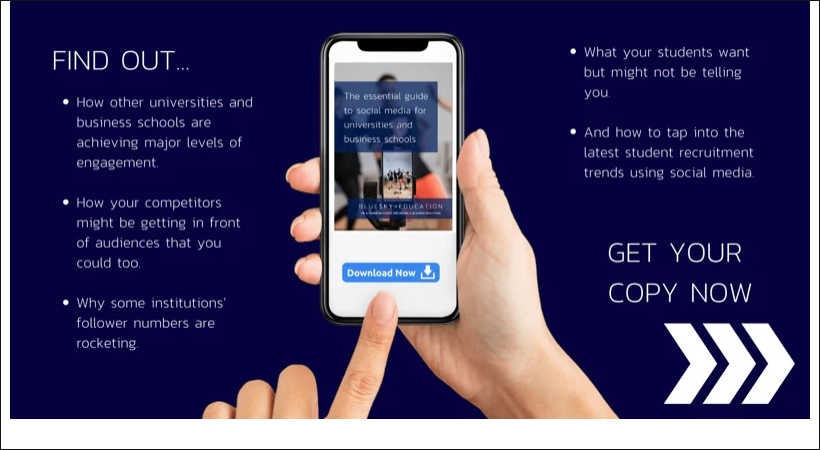Regardless of ranking, prestige or the specialisms a business school might offer, there is little doubt that part of what makes a programme uniquely valuable is the cohort.
Applicants are well aware that immersing themselves in an internationally and professionally diverse classroom makes for the most enriching of learning environments.
But, it can be hard to attract an international pool of applicants to your programme when so many other institutions are seeking to do the same. Whilst the Financial Times might only rank the world’s top 100 business schools there are, in reality, hundreds more in existence which either do not make or choose to opt out of the list.
Each of these institutions will offer a variety of programmes – common staples such as the MBA or MSc Management and other more specialised courses and, increasingly, these are delivered in a variety of formats.
To put it bluntly, the global business education market is a busy one!
Amongst these numbers, each institution is clamouring to be seen and heard by potential applicants. To become their institution of choice – whether they live five miles down the road or 5,000 miles across an ocean.
The bits schools can’t control… and the bits they can
An applicant’s decision-making typically focuses on a few practical criteria;
Perhaps most obviously there’s the rankings. Then, test scores such as the GMAT or GRE can also help an applicant to whittle down the many possibilities open to them.
Another key factor is the cost involved, possibilities of financial aid, and the practicalities of visas and other legal requirements.
The next set of considerations lie in personal preference. Perhaps an applicant has a desire to study in a particular locale, or to specialise their studies to a specific industry or require the flexibility that online or part-time studies offer.
There’s only so much an institution can do to change its fortunes in the rankings, or to adapt its costs or curriculum to better meet the needs of international learners. However, when it comes to appealing to personal preferences, there is plenty.
And, with GMAC reporting that fewer programmes are seeing growth in international applicants for MBA programmes, the time to act is now.
The power of public relations
How can an institution boost its visibility internationally and capture the interests of a wider range of applicants? Advertisements, recruitment events and marketing brochures can only take your campaign so far.
A smart approach to media relations is also vital. Engaging in international media relations is a sure-fire way to raise your institution’s visibility, but the options for how to do so can be overwhelming.
As a result, may schools opt for trying to be seen everywhere all at once, and spread themselves too thin. Rather than making the impact desired, they end up adding to the noise instead.
Business schools have all the ingredients for attracting the right people to their programmes at their fingertips; students, alumni, faculty and curriculum. Being able to apply them in the right way and in the right places is the key to setting one institution apart from another and bringing the world into the classroom.
1) Understanding your identity
It’s impossible to appeal to everyone, so in communicating to applicants why they should pick your business school over any other, sometimes the best step forward involves a step backwards first...
Institutions should take the time to conduct some honest self-reflection, speaking to their community can help them to understand what they do well, and also what they need to improve on. This information can be used to solidify the identity they present to the world, and help carve out a niche. Doing this can enable an institution to cut through the noise when it comes to capturing a journalist’s attention.
Most importantly, it can also help an institution to define the sorts of candidates they’re looking for, which also can help to identify potential press targets.
An additional benefit of reaching out to the community for feedback is identifying potential new ambassadors who can help with sharing and promoting an institution’s messages and values in media outlets. Having an army of ambassadors at our disposal allows institutions to not only share a wide spread of expertise publicly across multiple channels, but also can help to build consistency in messaging – reinforcing that an institution or programme can deliver exactly what it offers.
2) Broaden your horizons
Where are your target applicants? Each market a different kind of outreach than domestic media needs, a skill which agencies like BlueSky are well-versed in!
To reach new audiences, institutions must understand not only where they want to be seen, but who they want to be seen by. This means tapping into the interests and priorities of potential applicants, as well as those of the journalists and publications their potential applicants engage with.
Have you ever pushed out programme-related news on an international scale only to find there’s little to no response? Often an institutions priorities sit at odds with what its new audience needs from them. This is especially true when engaging with media outlets in other countries.
Instead, being able to offer up faculty for a well-timed comment on a locally relevant issue that suits your institution’s reputation and values can enable your institution to enter into local discourse, display its expertise and ability to keep pace with current issues, and boost its credibility and reputation as a result.
Tapping into the themes that matter to a publication and its readers is the difference between PR and advertising. You cannot have effective PR without developing news sense.
It pays to not just aim for the top tiers and engage with well-respected industry press, unfamiliar titles, even local language press. Such a strategy will not only give you more opportunities for public engagement but will help to bring you institution in front of a more diverse audience, attracting both a greater number but also a greater range of applicants as a result.
But, do your research before you reach out. Consider what each publication reports on and how they do it. Then match your own outreach to fit with their style.
Student priorities and experience
Understanding international applicant needs can also help you in tailoring your own PR and marketing efforts – helping you to not only secure media coverage, but coverage that provokes a response.
Enlisting your students and alumni to provide first-hand experiences of how those needs have been met lends an authentic air to your media outreach, and gives potential applicants a narrative to identify with. Sharing inspirational alumni stories with international media outlets is an effective method of demonstrating a programme’s ROI, outside of marketing materials.
Importantly, allowing students to share an honest account of their studies – discussing the realities of living in a new country, their favourite aspects and not glossing over difficulties but instead offering advice on how to overcome challenges can help ease any reservations international applicants might have, whilst giving them the full picture of what their lives might be like.
Publications all over the world carry such stories – from university-focused titles such as QS, BusinessBecause, Poets&Quants etc. and, of course, the all-important ranking reports.
Engaging with industry press here too can be useful as, when pitched correctly, alumni can share their professional success stories, which promotes the value of an institution’s programmes as a result.
Tapping into socials
Traditional media is no longer enough when it comes to international outreach. Social media not only where people share their most exciting life events but, increasingly, a research tool too. According to the 2023 QS International Student Survey, 56% of prospective international students use Instagram to research study abroad opportunities. TikTok too has become a go-to source for recommendations for the next generation.
Institutions which fail to be active across every channel are putting themselves at a disadvantage.
It is not enough to simply be present. Too many institutions are guilty of using social media like a bulletin board – posting news and updates and failing to engage with the responses those posts receive.
By interacting with posts and taking steps to reach new audiences rather than waiting for audiences to find them, institutions can boost visibility and develop a greater voice.
Social media also offers schools an increasingly rare public platform beyond their own websites to be more creative, and even promotional, in their outreach. Showcasing their programmes, student life and what makes them special through videos, reels, student takeovers, Q&As, and feeding comments into ongoing discussions in groups.
We have several social media guides which all offer practical, actionable advice on how to get started.
Events
Events may seem old hat, especially from a press perspective (we know all too well how tricky it can be to get a journalist to spend a day on campus) but welcoming the world onto the campus still provides an effective means of showcasing an institution’s strengths.
A new approach is needed. Rather than focusing on a physical headcount, events can be held virtually, offering applicants a chance to interact with an institution and peep behind the curtain.
Sharing experiences in events rather than just providing information can help to boost interest and engagement for all (not just applicants),
Allowing faculty and staff at all levels to engage in this way – not just the Dean – as well as students and alumni can help to foster better connections between applicants and an institution, allowing applicants a glimpse into an entire community to benefit from once they enrol.

Kerry is the Strategic Communications and Editorial Lead at BlueSky Education and a former BBC journalist. Recognised in the graduate management education arena as a leading authority on communications for the industry, Kerry has more than a decade of experience in the media and public relations.







